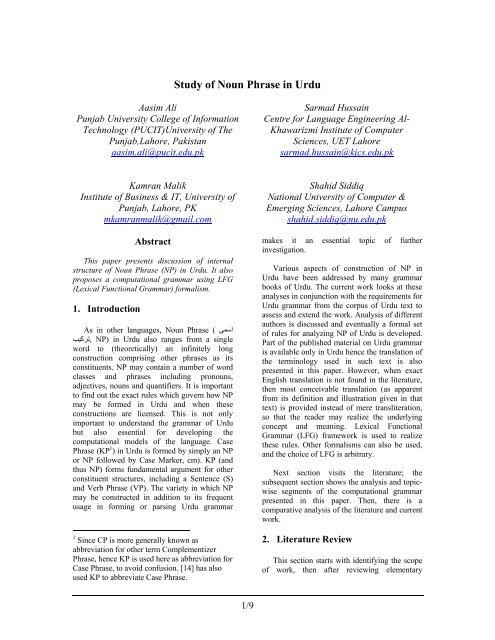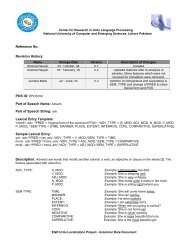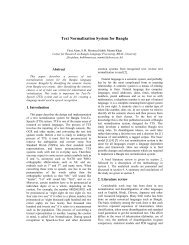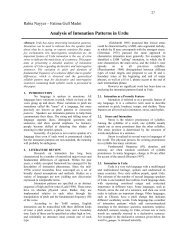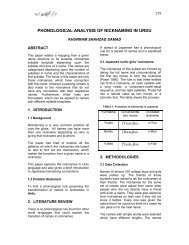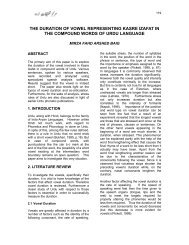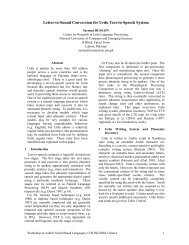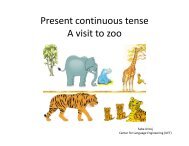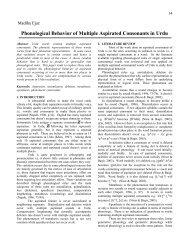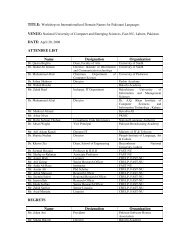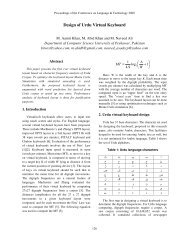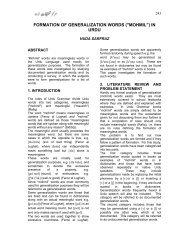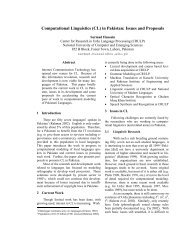Study of Noun Phrase in Urdu - Center for Language Engineering
Study of Noun Phrase in Urdu - Center for Language Engineering
Study of Noun Phrase in Urdu - Center for Language Engineering
You also want an ePaper? Increase the reach of your titles
YUMPU automatically turns print PDFs into web optimized ePapers that Google loves.
<strong>Study</strong> <strong>of</strong> <strong>Noun</strong> <strong>Phrase</strong> <strong>in</strong> <strong>Urdu</strong><br />
Aasim Ali<br />
Punjab University College <strong>of</strong> In<strong>for</strong>mation<br />
Technology (PUCIT)University <strong>of</strong> The<br />
Punjab,Lahore, Pakistan<br />
aasim.ali@pucit.edu.pk<br />
Sarmad Hussa<strong>in</strong><br />
Centre <strong>for</strong> <strong>Language</strong> Eng<strong>in</strong>eer<strong>in</strong>g Al-<br />
Khawarizmi Institute <strong>of</strong> Computer<br />
Sciences, UET Lahore<br />
sarmad.hussa<strong>in</strong>@kics.edu.pk<br />
Kamran Malik<br />
Institute <strong>of</strong> Bus<strong>in</strong>ess & IT, University <strong>of</strong><br />
Punjab, Lahore, PK<br />
mkamranmalik@gmail.com<br />
Abstract<br />
This paper presents discussion <strong>of</strong> <strong>in</strong>ternal<br />
structure <strong>of</strong> <strong>Noun</strong> <strong>Phrase</strong> (NP) <strong>in</strong> <strong>Urdu</strong>. It also<br />
proposes a computational grammar us<strong>in</strong>g LFG<br />
(Lexical Functional Grammar) <strong>for</strong>malism.<br />
1. Introduction<br />
اسمی ( <strong>Phrase</strong> As <strong>in</strong> other languages, <strong>Noun</strong><br />
NP) <strong>in</strong> <strong>Urdu</strong> also ranges from a s<strong>in</strong>gle ,ترکيب<br />
word to (theoretically) an <strong>in</strong>f<strong>in</strong>itely long<br />
construction compris<strong>in</strong>g other phrases as its<br />
constituents. NP may conta<strong>in</strong> a number <strong>of</strong> word<br />
classes and phrases <strong>in</strong>clud<strong>in</strong>g pronouns,<br />
adjectives, nouns and quantifiers. It is important<br />
to f<strong>in</strong>d out the exact rules which govern how NP<br />
may be <strong>for</strong>med <strong>in</strong> <strong>Urdu</strong> and when these<br />
constructions are licensed. This is not only<br />
important to understand the grammar <strong>of</strong> <strong>Urdu</strong><br />
but also essential <strong>for</strong> develop<strong>in</strong>g the<br />
computational models <strong>of</strong> the language. Case<br />
<strong>Phrase</strong> (KP 1 ) <strong>in</strong> <strong>Urdu</strong> is <strong>for</strong>med by simply an NP<br />
or NP followed by Case Marker, cm). KP (and<br />
thus NP) <strong>for</strong>ms fundamental argument <strong>for</strong> other<br />
constituent structures, <strong>in</strong>clud<strong>in</strong>g a Sentence (S)<br />
and Verb <strong>Phrase</strong> (VP). The variety <strong>in</strong> which NP<br />
may be constructed <strong>in</strong> addition to its frequent<br />
usage <strong>in</strong> <strong>for</strong>m<strong>in</strong>g or pars<strong>in</strong>g <strong>Urdu</strong> grammar<br />
1 S<strong>in</strong>ce CP is more generally known as<br />
abbreviation <strong>for</strong> other term Complementizer<br />
<strong>Phrase</strong>, hence KP is used here as abbreviation <strong>for</strong><br />
Case <strong>Phrase</strong>, to avoid confusion. [14] has also<br />
used KP to abbreviate Case <strong>Phrase</strong>.<br />
Shahid Siddiq<br />
National University <strong>of</strong> Computer &<br />
Emerg<strong>in</strong>g Sciences, Lahore Campus<br />
shahid.siddiq@nu.edu.pk<br />
makes it an essential topic <strong>of</strong> further<br />
<strong>in</strong>vestigation.<br />
Various aspects <strong>of</strong> construction <strong>of</strong> NP <strong>in</strong><br />
<strong>Urdu</strong> have been addressed by many grammar<br />
books <strong>of</strong> <strong>Urdu</strong>. The current work looks at these<br />
analyses <strong>in</strong> conjunction with the requirements <strong>for</strong><br />
<strong>Urdu</strong> grammar from the corpus <strong>of</strong> <strong>Urdu</strong> text to<br />
assess and extend the work. Analysis <strong>of</strong> different<br />
authors is discussed and eventually a <strong>for</strong>mal set<br />
<strong>of</strong> rules <strong>for</strong> analyz<strong>in</strong>g NP <strong>of</strong> <strong>Urdu</strong> is developed.<br />
Part <strong>of</strong> the published material on <strong>Urdu</strong> grammar<br />
is available only <strong>in</strong> <strong>Urdu</strong> hence the translation <strong>of</strong><br />
the term<strong>in</strong>ology used <strong>in</strong> such text is also<br />
presented <strong>in</strong> this paper. However, when exact<br />
English translation is not found <strong>in</strong> the literature,<br />
then most conceivable translation (as apparent<br />
from its def<strong>in</strong>ition and illustration given <strong>in</strong> that<br />
text) is provided <strong>in</strong>stead <strong>of</strong> mere transliteration,<br />
so that the reader may realize the underly<strong>in</strong>g<br />
concept and mean<strong>in</strong>g. Lexical Functional<br />
Grammar (LFG) framework is used to realize<br />
these rules. Other <strong>for</strong>malisms can also be used,<br />
and the choice <strong>of</strong> LFG is arbitrary.<br />
Next section visits the literature; the<br />
subsequent section shows the analysis and topicwise<br />
segments <strong>of</strong> the computational grammar<br />
presented <strong>in</strong> this paper. Then, there is a<br />
comparative analysis <strong>of</strong> the literature and current<br />
work.<br />
2. Literature Review<br />
This section starts with identify<strong>in</strong>g the scope<br />
<strong>of</strong> work, then after review<strong>in</strong>g elementary<br />
1/9
constituents <strong>of</strong> NP, the phrasal constituents are<br />
looked at, <strong>in</strong> this section <strong>of</strong> the paper.<br />
2.1. Scope <strong>of</strong> this paper<br />
This paper studies NP construction <strong>for</strong> the<br />
purpose <strong>of</strong> computation grammar <strong>for</strong> <strong>Urdu</strong>. The<br />
NP can conta<strong>in</strong> clauses, other phrases, and<br />
elementary items as its constituent. Some<br />
constituents (phrases and clauses) <strong>of</strong> NP also<br />
have the ability <strong>of</strong> tak<strong>in</strong>g NP as their constituent<br />
(relative clause, postpositional phrase, and case<br />
phrase etc.); while others always appear at a<br />
subord<strong>in</strong>at<strong>in</strong>g position <strong>of</strong> NP (e.g. noun,<br />
pronoun, numeral, non-verbal adjective). This<br />
paper focuses on such subord<strong>in</strong>at<strong>in</strong>g items only,<br />
because each <strong>of</strong> other constructions requires its<br />
separate study and analysis. There<strong>for</strong>e, genitive<br />
pronoun and verbal adjectives are also not<br />
<strong>in</strong>cluded <strong>in</strong> this paper.<br />
Handl<strong>in</strong>g <strong>of</strong> the coord<strong>in</strong>ate conjunction <strong>of</strong> NP<br />
and adjectives is also <strong>in</strong>cluded <strong>in</strong> the current<br />
grammar.<br />
2.2. Elementary Items<br />
This section reviews the literature available<br />
on elementary constituents <strong>of</strong> the NP.<br />
(اسم) 2.2.1. The <strong>Noun</strong><br />
Ox<strong>for</strong>d English Dictionary [3] describes<br />
<strong>Noun</strong> as “A word used as the name or<br />
designation <strong>of</strong> a person, place, or th<strong>in</strong>g; the class<br />
or category <strong>of</strong> such words.” WordNet [1] def<strong>in</strong>es<br />
noun semantically as “a content word that can be<br />
used to refer to a person, place, th<strong>in</strong>g, quality, or<br />
action”, or functionally as “the word class that<br />
can serve as the subject or object <strong>of</strong> a verb, the<br />
object <strong>of</strong> a preposition, or <strong>in</strong> apposition.” <strong>Noun</strong>s<br />
are generally divided <strong>in</strong>to many sub-classes,<br />
which <strong>in</strong>clude common vs. proper nouns, and<br />
mass vs. countable nouns (e.g. see [Jurafsky]).<br />
Further sub-classes may also be def<strong>in</strong>ed based on<br />
syntactic, grammatical or semantic roles <strong>of</strong><br />
different nouns. <strong>Urdu</strong> grammarians have also<br />
sub-classified the nouns, which are discussed<br />
below.<br />
Haq [6] divides the nouns <strong>in</strong> two ma<strong>in</strong><br />
.(اسم عام) and common (اسم خاص) classes, proper<br />
Proper nouns are further divided <strong>in</strong>to four subclasses,<br />
title ,(خطاب) attributive name ,(لقب) alias<br />
and common ,(تخلّص) and nom-de-plume (عرف)<br />
,(کيفيت) nouns are sub-classified as state<br />
collective ,(جمع) locative (ظرف) and <strong>in</strong>strumental<br />
nouns. Haq further divides the locative noun (آلہ)<br />
<strong>in</strong>to nouns which represent a “location” <strong>in</strong> space<br />
.(ظرفِ زماں) and time (ظرفِ مکاں)<br />
Javed [5] divides the nouns flatly <strong>in</strong>to five<br />
types, common ( ام ,(ع proper ,(خاص) collective<br />
non- and mass (or (مجرد) abstract ,(جمع)<br />
countable, شماری ,غير also referred to as material,<br />
nouns. Platts [9] does not explicitly discuss (مادہ<br />
the types, but divides nouns <strong>in</strong>to five classes<br />
based on morphological behavior. He lists<br />
abstract nouns, nouns <strong>of</strong> agency or attributes or<br />
possession or appellations, nouns <strong>of</strong> place,<br />
dim<strong>in</strong>utive nouns and compounds.<br />
Siddiqui [8] presents the most comprehensive<br />
classification <strong>of</strong> nouns. He divides the<br />
,(ساخت) classification on the basis <strong>of</strong> structure<br />
nature (نوعيّت) and other. The classification on<br />
the basis <strong>of</strong> structure (ساخت) is as follows:<br />
a. Primitive (neither derived nor derivable) <strong>Noun</strong><br />
which is sub-classified as proper ,(اسم جامد)<br />
nouns. The proper (عام) and common (خاص)<br />
nouns are further sub-categorized as title<br />
,(لقب) Appellation or Attributive Name ,(خطاب)<br />
Alias ,(عرف) nom-de-plume (تخلّص) and<br />
k<strong>in</strong>ship .(کُنيّت) The common nouns are sub-<br />
(جمع) and collective (کيفيت) categorized as state<br />
nouns.<br />
b. Verbal <strong>Noun</strong> مصدر) ,(اسم which is the <strong>in</strong>f<strong>in</strong>itive<br />
and gerund <strong>for</strong>m <strong>of</strong> verb, and generally used as<br />
noun. The derivational noun below is derived<br />
from verbal noun.<br />
c. Derivational <strong>Noun</strong> مشتق) ,(اسم which is sub-<br />
,(مفعول) object ,(فاعل) classified <strong>in</strong>to subject<br />
present ,(حاليہ) deverbal مصدر) ,(حاصل wage<br />
name <strong>of</strong> the payment derived from the ,معاوضہ)<br />
name <strong>of</strong> the work <strong>for</strong> which the payment is<br />
due), locative ,ظرف) <strong>in</strong>cludes locative <strong>in</strong><br />
), ا “space” and <strong>in</strong> ظرفِ زماں “time”<br />
and <strong>in</strong>strumental (آلہ) nouns.<br />
مک ں ظرفِ<br />
The classification <strong>of</strong> nouns accord<strong>in</strong>g to<br />
nature (نوعيّت) is as substantive ,(موصوف) quality<br />
F<strong>in</strong>ally, .(ضمير) nouns and pronouns (صفت)<br />
Siddiqui lists other classes <strong>of</strong> nouns as sound<br />
,(موصول) relative ,(کنايہ) <strong>in</strong>def<strong>in</strong>ite ,(صوت)<br />
<strong>in</strong>terrogative ,(استفہام) numeral ,(عدد) comparative<br />
nouns. (مبالغہ) and exaggerative (تفضيل)<br />
2/9
[13] and [9] have not hierarchical categorization<br />
<strong>of</strong> noun <strong>in</strong> this way, they have studied the<br />
phenomenon <strong>of</strong> their morphological<br />
construction.<br />
[8] has shown some categories <strong>of</strong> noun<br />
without embedd<strong>in</strong>g them <strong>in</strong>to the hierarchy <strong>of</strong><br />
ma<strong>in</strong> types, viz. sound noun صوت) ,اسم names <strong>for</strong><br />
sounds <strong>of</strong> animals or mach<strong>in</strong>es etc.), <strong>in</strong>def<strong>in</strong>ite<br />
pronoun کنايہ) ,اسم the translation is referred from<br />
[9] on the basis <strong>of</strong> description and illustrations <strong>of</strong><br />
اسمائے <strong>in</strong>def<strong>in</strong>ite pronouns (translated by Platts as<br />
(any) کوئ ی words: given there<strong>in</strong>, <strong>in</strong>cludes (تنيکر<br />
,(اسم موصول) (some)), relative pronoun کچه and<br />
اسم ( card<strong>in</strong>al ,(اسم استفہام) <strong>in</strong>terrogative pronoun<br />
comparative adjective ( ), <strong>in</strong>tensity ,(عدد<br />
adjective مبالغہ) ,(اسم and demonstrative pronoun<br />
Card<strong>in</strong>al are discussed <strong>in</strong> numeral .(اسم اشارہ)<br />
phrase (2.3.1 below); <strong>in</strong>def<strong>in</strong>ite pronoun,<br />
<strong>in</strong>terrogative pronoun, and demonstrative<br />
pronoun are discussed <strong>in</strong> pronouns (2.2.2 below);<br />
and comparative adjective and <strong>in</strong>tensity adjective<br />
are discussed under adjective phrase (2.3.2<br />
below).<br />
اسم تفضيل<br />
As can be seen, different authors have done<br />
different classifications. These classifications are<br />
based on morpho-phonological, syntactic and<br />
semantic behavior <strong>of</strong> nouns.<br />
Proper noun and common noun are the most<br />
common set (or subset) <strong>of</strong> types (noted <strong>in</strong> all the<br />
referenced texts). <strong>Urdu</strong> has no <strong>in</strong>dication <strong>in</strong> the<br />
script to identify the proper noun (as opposed to<br />
the capitalization <strong>in</strong> English), but the<br />
grammatical dist<strong>in</strong>ction exists. Proper noun does<br />
not take plural declension while common noun<br />
does, <strong>in</strong> general. There are special uses <strong>of</strong> proper<br />
noun when it is not behav<strong>in</strong>g typically:<br />
“That person is<br />
Haatam <strong>of</strong> his days.”<br />
[6]<br />
“He is Rustam <strong>of</strong> H<strong>in</strong>d.”<br />
“These days Haatams پيدا نہيں ہوتے۔<br />
are not borne”<br />
[6] and [8] have also noted this exceptional<br />
usage <strong>of</strong> proper noun.<br />
وہ شخص اپنے وقت کا [حاتم] ہے۔ [6]<br />
وہ [رستم] ہند ہے۔<br />
آج کل [حاتم] [5]<br />
In the above mentioned usage, proper noun is<br />
used to refer to some property, state, or feature <strong>in</strong><br />
the context, there<strong>for</strong>e [6] has called it adjective.<br />
[5] has not given it any specific name however<br />
he writes that whenever a proper noun is used <strong>in</strong><br />
metaphoric behavior, it starts accept<strong>in</strong>g plural as<br />
does the common noun. [8] has called such an<br />
<strong>in</strong>stance <strong>of</strong> proper noun as adjective (because it<br />
is signify<strong>in</strong>g some attribute <strong>of</strong> the entity own<strong>in</strong>g<br />
this proper noun), <strong>for</strong> its be<strong>in</strong>g the sub-type <strong>of</strong><br />
generalized noun نکرہ) ,اسم a proper noun made<br />
common through کيرتن , Arabic word <strong>for</strong><br />
generalization, so it can be termed generalized<br />
noun, hence<strong>for</strong>th), justifies it by dist<strong>in</strong>guish<strong>in</strong>g it<br />
from regular common noun.<br />
The Inf<strong>in</strong>itive <strong>for</strong>m <strong>of</strong> Verb <strong>in</strong> <strong>Urdu</strong> mostly<br />
behaves as noun entry (and sometimes as a verb<br />
to show the aspect <strong>of</strong> necessity. [9] has used both<br />
labels (Inf<strong>in</strong>itive and Verbal <strong>Noun</strong>) to refer to<br />
this type. [9] has also mentioned that Gerund <strong>in</strong><br />
<strong>Urdu</strong> also has the same shape (as <strong>of</strong> Inf<strong>in</strong>itive)<br />
and behaves as Verbal <strong>Noun</strong>.<br />
[5] has stated Non-Count <strong>Noun</strong> and its<br />
synonym مادہ ,اسم which may be translated as<br />
Material <strong>Noun</strong> or Mass <strong>Noun</strong>, to be the same<br />
concept. [12] has def<strong>in</strong>ed Material <strong>Noun</strong> as<br />
someth<strong>in</strong>g that is used as <strong>in</strong>gredient <strong>of</strong> other<br />
product (made <strong>of</strong>/from the <strong>for</strong>mer), <strong>for</strong> example:<br />
“This cake is made with lot <strong>of</strong> [eggs]. A<br />
bracelet <strong>of</strong> [solid gold]. A man <strong>of</strong> [steel].”<br />
The first example <strong>in</strong>dicat<strong>in</strong>g “eggs” as<br />
Material <strong>Noun</strong> is apparently contradict<strong>in</strong>g with<br />
the def<strong>in</strong>ition <strong>of</strong> Non-Count <strong>Noun</strong>, but the other<br />
گيہوں side <strong>of</strong> the picture is that the example <strong>of</strong><br />
(wheat) as Non-Count <strong>Noun</strong> seems apparently<br />
uncountable because <strong>of</strong> the size <strong>of</strong> each gra<strong>in</strong> <strong>in</strong><br />
proportion to their number, which somehow<br />
justifies the “eggs” especially <strong>in</strong> a bulk quantity<br />
(or may be when the number is not known). [5]<br />
is the only grammar writer who has noted this<br />
k<strong>in</strong>d <strong>of</strong> the <strong>Noun</strong>. An important property <strong>of</strong> this<br />
type <strong>of</strong> noun is that they do not accept Numeral<br />
Adjective; rather they are measured <strong>in</strong> quantity<br />
so they accept Quantify<strong>in</strong>g Adjective (a.k.a.<br />
Quantifier). Nevertheless, this k<strong>in</strong>d is very<br />
important and useful to separate from other<br />
nouns especially when focus<strong>in</strong>g on<br />
computational aspects <strong>for</strong> the sake <strong>of</strong> agreement<br />
with context (<strong>in</strong> terms <strong>of</strong> selection <strong>of</strong> one <strong>of</strong> the<br />
two, Numeral and Quantifier).<br />
دو پيالی “ that However, it is also observed<br />
”دو چائے“ (two cups <strong>of</strong> tea) is shortened to ”چائے<br />
(two teas). Here the measurement unit is<br />
presumed to be ,”پيالی“ because <strong>of</strong> the nature <strong>of</strong><br />
substance <strong>in</strong> question, and the m<strong>in</strong>dset <strong>of</strong> the<br />
participants <strong>of</strong> conversation. In such uses <strong>of</strong><br />
Numerals (with Non-Count <strong>Noun</strong>) context is<br />
very important, <strong>for</strong> example چاول“ ”دو (two rice)<br />
may refer to پليٹ چاول“ ”دو (two plates <strong>of</strong> rice) or<br />
3/9
(two bowls <strong>of</strong> rice) depend<strong>in</strong>g on ”دو “<br />
the measurement unit most frequently used<br />
between the participants <strong>of</strong> conversation.<br />
پيالے چاول<br />
(اسم ضمير ( Pronoun 2.2.2. The<br />
[9] has divided pronoun <strong>in</strong>to demonstrative<br />
ضمير ( pronoun personal ,(صفت ضميری) pronoun<br />
,(ضمير موصولہ) relative pronoun ,(شخصی<br />
,(جواب اسم موصول) correlative pronoun<br />
<strong>in</strong>terrogative pronoun استفہام) ,(ضمير <strong>in</strong>def<strong>in</strong>ite<br />
ضمير ( pronoun reflexive ,(ضمير تنکير) pronoun<br />
and ,(ضمير باہمی) reciprocal pronoun ,(معکوس<br />
pronom<strong>in</strong>al adjectives ( ضميری .(صفات Only [9]<br />
has noted the pronoun type correlative, however,<br />
personal pronoun is used <strong>in</strong>stead <strong>of</strong> correlative<br />
pronoun <strong>in</strong> modern <strong>Urdu</strong> [9].<br />
[5] has classified pronouns <strong>in</strong>to personal<br />
(with subclass honorific), reflexive,<br />
demonstrative, genitive (), common genitive,<br />
متعلق ( adverbial <strong>in</strong>def<strong>in</strong>ite, <strong>in</strong>terrogative, relative,<br />
, with subclasses, locative, temporal,<br />
and manner).<br />
ضمير فعلی<br />
[6] has categorized pronouns <strong>in</strong>to personal,<br />
relative, <strong>in</strong>terrogative, demonstrative, and<br />
<strong>in</strong>def<strong>in</strong>ite.<br />
[8] has noted personal pronoun, relative<br />
pronoun, <strong>in</strong>terrogative pronoun, demonstrative<br />
pronoun, <strong>in</strong>def<strong>in</strong>ite pronoun, and pronom<strong>in</strong>al<br />
adjectives to be the types <strong>of</strong> pronoun. [8] has<br />
divided the pronoun <strong>in</strong>to demonstrative pronoun,<br />
personal pronoun, relative pronoun, <strong>in</strong>terrogative<br />
pronoun, and <strong>in</strong>def<strong>in</strong>ite pronoun. [8] has shown<br />
honorific pronoun تعظيمی) (ضمير and reflexive<br />
pronoun to the sub-type <strong>of</strong> personal pronoun. [8]<br />
has also noted that the word جو (who) is the only<br />
relative pronoun <strong>in</strong> <strong>Urdu</strong>, and has other <strong>for</strong>ms<br />
like جسے (to whom) is the oblique <strong>for</strong>m.<br />
[13] has shown demonstrative, personal,<br />
reflexive, <strong>in</strong>terrogative, <strong>in</strong>def<strong>in</strong>ite, relative, and<br />
repeated pronouns. The last type seems a<br />
morphological phenomenon <strong>of</strong> reduplication.<br />
However, the reduplications illustrated <strong>in</strong> the text<br />
are lexicalized (not generative).<br />
2.3. Phrasal Items<br />
This section reviews the literature available<br />
on phrasal constituents <strong>of</strong> the NP. S<strong>in</strong>ce, the<br />
genitive phrase (thus the genitive pronoun) is<br />
considered to be the KP hence, excluded from<br />
the discussion <strong>of</strong> NP.<br />
(اسم صفت ( Adjectives 2.3.1. The<br />
[6] has divided adjectives <strong>in</strong>to personal<br />
صفت ( adjective associative ,(صفت ذاتی) adjective<br />
صفت ( adjective card<strong>in</strong>al and pronom<strong>in</strong>al ,(نسبتی<br />
and demonstrative ,(صفت مقداری) quantifier ,(عددی<br />
.(صفت ضميری) pronoun<br />
[5] has categorized adjectives as personal<br />
adjective, card<strong>in</strong>al and pronom<strong>in</strong>al, quantifier,<br />
<strong>in</strong>tensity adjective ( ,(صفت demonstrative<br />
pronoun ( ی ,(صفت and comparative<br />
.(درجہ) adjective<br />
تشديد ی<br />
ضمير<br />
[8] has classified adjectives as personal<br />
adjective ( ), associative adjective,<br />
card<strong>in</strong>al and pronom<strong>in</strong>al adjective (also <strong>in</strong>cludes<br />
fraction کسری) (عدد as its subclass), and ord<strong>in</strong>al<br />
.(صفت عددی (<br />
مشبہ صفت<br />
[13] has shown <strong>in</strong>terrogative pronoun,<br />
<strong>in</strong>def<strong>in</strong>ite pronoun, adverbial pronoun (near, far,<br />
<strong>in</strong>terrogative, and relative), repeated adjective,<br />
and comparative adjective to be the types <strong>of</strong><br />
adjectives. [13] has also noted possessive<br />
adjective, reflexive possessive adjective,<br />
numbers, and participles used as adjective.<br />
[9] has studied morphological behavior <strong>of</strong><br />
<strong>Urdu</strong> adjectives.<br />
[5] has shown that the adjective usually<br />
precedes the noun but <strong>for</strong> emphasis it may<br />
follow. In the follow<strong>in</strong>g example the adjective is<br />
used at the end <strong>of</strong> the sentence:<br />
(Jamil was tired when جميل تهکا ماندہ گهر پہنچا۔<br />
reached home.)<br />
I) saw ميں نے ايک غار ديکها۔ بهيانک، تاريک، اور گہرا۔<br />
a cave – scary, dark, and obscure)<br />
The difference <strong>of</strong> order <strong>in</strong> the above<br />
examples is to emphasize on the specific<br />
attribute <strong>of</strong> the substantive.<br />
[9] has noted the use <strong>of</strong> genitive construction<br />
(us<strong>in</strong>g genitive diacritic اضافت ,(زيرِ accord<strong>in</strong>g to<br />
the rules <strong>of</strong> borrowed Persian Morphology<br />
(hence generally used with borrowed Persian<br />
words), where Adjective comes after the Head<br />
<strong>Noun</strong> <strong>in</strong> the <strong>Noun</strong> <strong>Phrase</strong>, e.g. مردِ نيک (a good<br />
man, literally “a man <strong>of</strong> good”). However, this<br />
construction is not frequently used <strong>in</strong><br />
contemporary <strong>Urdu</strong>.<br />
2.3.2. The Numerals<br />
4/9
[9] has listed numerals apart from adjectives,<br />
and has subdivided them <strong>in</strong>to card<strong>in</strong>al, ord<strong>in</strong>al,<br />
collective numeral, distributive and multiplicative,<br />
numeral adverb, fractional number,<br />
currency (rakam).<br />
[13] has also listed numerals apart from<br />
adjectives, and has categorized them as card<strong>in</strong>al<br />
numbers, ord<strong>in</strong>al numbers, fractions, frequency<br />
(once, twice, etc.), multiplicative, repeated numbers,<br />
and numbers with oblique plurals.<br />
[6], [5], and [8] have noted numerals as type<br />
<strong>of</strong> adjectives, hence, listed <strong>in</strong> the adjec-tive<br />
phrase (section 2.3.2) below.<br />
2.4. Features and Agreement<br />
The term لوازم اسم (Essentials <strong>of</strong> <strong>Noun</strong>) is used<br />
by Maulvi Abdul Haq [HQ1, p 14], to discuss<br />
the features <strong>of</strong> the constituents <strong>of</strong> the NP, and<br />
their agreement requirement to <strong>for</strong>m a<br />
grammatically valid NP. Every noun (and some<br />
other constituents <strong>of</strong> NP, e.g. adjective) <strong>in</strong> <strong>Urdu</strong><br />
has the Gender (جنس) feature, which needs to<br />
agree with the head <strong>of</strong> the NP be<strong>in</strong>g <strong>for</strong>med.<br />
When a constituent (e.g. whole number) does not<br />
have the gender restriction <strong>for</strong> attachment, it is<br />
said to have neutral gender which means it has<br />
set <strong>of</strong> all possible values <strong>for</strong> that feature <strong>in</strong> <strong>Urdu</strong>,<br />
i.e., mascul<strong>in</strong>e and fem<strong>in</strong><strong>in</strong>e, as the value <strong>for</strong> its<br />
gender feature.<br />
Productive Morphotactics have been<br />
observed <strong>in</strong> <strong>Urdu</strong> <strong>for</strong> the identification <strong>of</strong> the<br />
gender and number <strong>of</strong> a noun from its shape, but<br />
لڑکا e.g. <strong>in</strong> reality, it is a lexical phenomenon,<br />
(boy, example <strong>of</strong> marked mascul<strong>in</strong>e s<strong>in</strong>gular<br />
noun; the mark is end<strong>in</strong>g vowel) vs. دعا (prayer,<br />
example <strong>of</strong> a noun hav<strong>in</strong>g same mark but it is<br />
fem<strong>in</strong><strong>in</strong>e s<strong>in</strong>gular), and لڑکی (girl, example <strong>of</strong> a<br />
marked fem<strong>in</strong><strong>in</strong>e noun; the mark is end<strong>in</strong>g<br />
vowel) vs. ہاتهی (elephant, example <strong>of</strong> a noun<br />
hav<strong>in</strong>g same mark but it is mascul<strong>in</strong>e s<strong>in</strong>gular).<br />
The feature <strong>of</strong> honor, <strong>in</strong> <strong>Urdu</strong>, overrides the<br />
feature <strong>of</strong> number: a s<strong>in</strong>gular starts requir<strong>in</strong>g<br />
plural agreement due to <strong>in</strong>creased honor, e.g.<br />
(The اساتذہ آئے vs. (The teacher came) استاد آيا<br />
teachers came) vs. استاد صاحب آئے (Respected<br />
teacher came). It also shows that the agreement<br />
is not restricted to NP and its constituents only,<br />
rather is witnessed across other phrases <strong>of</strong> the<br />
sentence, as well.<br />
(حالت) [11] has noted that explicit case<br />
mark<strong>in</strong>g is useful <strong>for</strong> the establishment <strong>of</strong> the<br />
semantic roles <strong>of</strong> nouns (and pronouns) and their<br />
syntactic relationship to the verb. The freedom<br />
<strong>in</strong> phrase order <strong>in</strong> <strong>Urdu</strong> language is due to<br />
explicit case mark<strong>in</strong>g. For example:<br />
ےن<br />
ےن<br />
ديکها۔<br />
] [ gives the same mean<strong>in</strong>g as<br />
] [ ديکها۔<br />
(The girl looked at the<br />
door.)<br />
لڑکی<br />
دروازے<br />
دروازے [کو] لڑکی<br />
[کو]<br />
”لڑکی“ marks that ”نے“ example, In the above<br />
is the agent (or the Subject, do<strong>in</strong>g the act <strong>of</strong><br />
see<strong>in</strong>g) and ”کو“ marks the preced<strong>in</strong>g noun<br />
to be the patient (or the Object, the th<strong>in</strong>g ”دروازہ“<br />
be<strong>in</strong>g seen). So the case is a tool <strong>for</strong> mark<strong>in</strong>g<br />
relationships between dependents and the head<br />
[11].<br />
Shape (<strong>for</strong>m) <strong>of</strong> the gender marked noun also<br />
changes on the basis <strong>of</strong> attachment <strong>of</strong> Case<br />
Marker [13]:<br />
(a) Nom<strong>in</strong>ative (فاعلی) <strong>for</strong>m: Only <strong>for</strong><br />
Nom<strong>in</strong>ative Case<br />
(b) Vocative (ندائی) <strong>for</strong>m: Only <strong>for</strong> Vocative<br />
Case. This <strong>for</strong>m does not exist <strong>for</strong><br />
Verbal <strong>Noun</strong>s [9].<br />
(c) Oblique (غيرندائی) <strong>for</strong>m: For all other<br />
Cases (requir<strong>in</strong>g separate word, case<br />
marker, to follow)<br />
Usually a countable noun allows plural<br />
<strong>in</strong>flection and can follow a card<strong>in</strong>al or<br />
pronom<strong>in</strong>al adjective, whereas a non-count noun<br />
allows pronom<strong>in</strong>al attachment <strong>of</strong> quantifier. This<br />
constra<strong>in</strong>t <strong>of</strong> attachment cannot be implemented<br />
without hav<strong>in</strong>g a feature to <strong>in</strong>dicate whether the<br />
noun is a count or non-count.<br />
3. Proposed Grammar with Analysis<br />
The proposed grammar is written us<strong>in</strong>g the<br />
notation <strong>of</strong> Lexical Functional Grammar. It is<br />
<strong>in</strong>cremented with discussion on every addition.<br />
3.1. The <strong>Noun</strong><br />
The computational analysis <strong>of</strong> the <strong>Noun</strong><br />
portion <strong>of</strong> the Substantive<strong>Phrase</strong> (NP consist<strong>in</strong>g<br />
substantive noun only) has shown that<br />
theoretically <strong>in</strong>f<strong>in</strong>ite substantive nouns can occur<br />
<strong>in</strong> an NP.<br />
5/9
The Adjective <strong>Phrase</strong> may conta<strong>in</strong> multiple<br />
adjectival items.<br />
The Substantive<strong>Noun</strong> is a POS (Part <strong>of</strong><br />
Speech) that means Substantive <strong>Noun</strong>, this term<br />
is used after [8] and [9]. This word is more<br />
precise and specific than the term <strong>Noun</strong> that has<br />
broader sense. A substantive noun refers to the<br />
generic concept that <strong>in</strong>cludes common noun and<br />
proper noun etc. Add<strong>in</strong>g the features to this<br />
grammar rule gives:<br />
Substantive<strong>Phrase</strong> must be modified to<br />
<strong>in</strong>corporate the Adjectival<strong>Phrase</strong> (Adjective<br />
<strong>Phrase</strong>):<br />
S<strong>in</strong>ce the unification works <strong>for</strong> the agreement<br />
<strong>of</strong> feature values <strong>of</strong> the current item with its<br />
compos<strong>in</strong>g parent hence only last noun <strong>in</strong> the<br />
str<strong>in</strong>g <strong>of</strong> nouns is coded <strong>for</strong> agreement,<br />
consider<strong>in</strong>g the last noun to be the head <strong>of</strong> the<br />
NP, most <strong>of</strong> the times, <strong>in</strong> <strong>Urdu</strong>.<br />
3.2. Pronoun<br />
As the genitive phrase is not <strong>in</strong> the scope <strong>of</strong><br />
this paper there<strong>for</strong>e it is not modeled here<strong>in</strong>.<br />
The Adjectival<strong>Phrase</strong> is kept optional. The<br />
subsections <strong>in</strong> this section analyze and build the<br />
grammar <strong>for</strong> <strong>in</strong>corporation <strong>of</strong> the constituents <strong>of</strong><br />
adjective phrase.<br />
3.4. The Numeral <strong>Phrase</strong><br />
General numerals are complex and <strong>of</strong><br />
recursive nature so it is better to devise a<br />
component/tool that assists the grammar<br />
application <strong>in</strong> this regard. For example:<br />
(three hundred تين سوپندرہ لاکه ساٹه ہزار چار سو تيرہ ۔<br />
and fifteen lakh sixty thousand four hundred and<br />
thirteen)<br />
3.4.1. Quantifier<br />
Quantifiers occur be<strong>for</strong>e typical adjectives.<br />
In the above rule, Demonstrative refers to the<br />
demonstrative pronoun, and parentheses around<br />
this POS show its be<strong>in</strong>g optional. The<br />
Substantive<strong>Phrase</strong>, so far, is same as coded<br />
above. Pronoun is the POS assigned to all<br />
pronoun types except the demonstrative pronoun<br />
and genitive pronoun. It is important to notice<br />
that the Pronoun construction is prevented from<br />
Demonstrative attachment.<br />
(ترکيبِ توصيفی) 3.3. Adjective <strong>Phrase</strong><br />
3.4.2. Card<strong>in</strong>al<br />
Card<strong>in</strong>al is the whole number, and may<br />
<strong>in</strong>troduce extra complexity to the grammar if<br />
generated as ord<strong>in</strong>ary production rule. So it was<br />
analyzed that to keep the grammar relevant to the<br />
6/9
grammatical aspects. This idea entails that there<br />
exists a small program <strong>in</strong>voked from the<br />
grammar to generate or validate the complicated<br />
<strong>for</strong>mation <strong>of</strong> the (theoretically) <strong>in</strong>f<strong>in</strong>itely long<br />
whole number, referred to as CompositeCard<strong>in</strong>al<br />
here.<br />
3.4.4. Multiplicative<br />
Multiplicative also cause similar extension<br />
the grammar so far.<br />
Thus the Adjectival<strong>Phrase</strong> will become:<br />
Multiplicative is the POS <strong>for</strong> such words <strong>in</strong><br />
the lexicon; and the ellipses are just shown here<br />
to <strong>in</strong>dicate that previous rule is extended, not<br />
replaced.<br />
In the above rule, Substantive<strong>Phrase</strong> is<br />
extended (the ellipses are just shown here to<br />
<strong>in</strong>dicate that previous rule is extended, not<br />
replaced) to <strong>in</strong>corporate Numeral<strong>Phrase</strong> is kept<br />
optional, when it occurs it conta<strong>in</strong>s noth<strong>in</strong>g but a<br />
CompositeCard<strong>in</strong>al, till this stage. Feature<br />
agreement/unification ensures that value <strong>of</strong> the<br />
card<strong>in</strong>al must agree with the number feature <strong>of</strong><br />
the head <strong>of</strong> the Substantive<strong>Phrase</strong> (which is the<br />
parent production <strong>of</strong> the Numeral<strong>Phrase</strong>). The<br />
CompositeCard<strong>in</strong>al constructs or validates the<br />
construction <strong>of</strong> the number which is a valid<br />
str<strong>in</strong>g <strong>of</strong> Card<strong>in</strong>als where Card<strong>in</strong>al is the POS<br />
assigned to such words.<br />
3.4.3. Ord<strong>in</strong>als<br />
Occurrence pattern <strong>of</strong> ord<strong>in</strong>al is same as that<br />
<strong>of</strong> demonstrative pronoun, so the <strong>Noun</strong><strong>Phrase</strong><br />
must <strong>in</strong>corporate it at par with Demonstrative:<br />
3.4.5. Fractions<br />
<strong>Urdu</strong> has two types <strong>of</strong> fractions, viz. Suffix<br />
تين چوتهائی precede, Fractions (a Card<strong>in</strong>al may<br />
(three-fourth)), and Prefix Fractions (a Unit<br />
Card<strong>in</strong>al always follows, ڈيڑه ہزار (one and a half<br />
thousand)).<br />
Card<strong>in</strong>al, FractionalSuffix, FractionalPrefix,<br />
and UnitCard<strong>in</strong>al are the POS <strong>for</strong> the words <strong>of</strong><br />
these categories; and the ellipses are just shown<br />
here to <strong>in</strong>dicate that previous rule is extended,<br />
not replaced.<br />
This is changed <strong>Noun</strong><strong>Phrase</strong> rule (not added).<br />
Here Ord<strong>in</strong>al is the POS <strong>for</strong> ord<strong>in</strong>al words <strong>in</strong> the<br />
lexicon. It must be noticed that whole<br />
construction be<strong>for</strong>e the Substantive<strong>Phrase</strong> <strong>in</strong> this<br />
rule is optional.<br />
3.5. POS Modify<strong>in</strong>g Particles<br />
There a few morphemes <strong>in</strong> <strong>Urdu</strong> that are<br />
handled syntactically <strong>in</strong> this work because <strong>of</strong><br />
their orthographic separation from previous<br />
token.<br />
3.5.1. vaalaa (والا) Construction<br />
7/9
The والاword 2 (say, vaalaa-morpheme) has an<br />
importance while work<strong>in</strong>g on computational<br />
grammar <strong>of</strong> <strong>Urdu</strong>; it adds complexity to the<br />
analysis <strong>of</strong> NP. There are some suffixes shown<br />
<strong>in</strong> [8] that can be used to make noun from an<br />
exist<strong>in</strong>g verb, <strong>of</strong> which vaalaa-morpheme is the<br />
most open to be used as suffix <strong>for</strong> this purpose.<br />
In fact, it <strong>for</strong>ms Adjective <strong>Phrase</strong>, and occurs<br />
be<strong>for</strong>e the head noun <strong>of</strong> the <strong>Noun</strong> <strong>Phrase</strong>. Just<br />
like any other adjective, vaalaa-construction, also<br />
becomes a noun when the head noun is absent <strong>in</strong><br />
the NP, <strong>for</strong> example:<br />
(The mad man spoke.) is same as پاگل آدمی بولا۔<br />
(The mad man spoke.); here dropp<strong>in</strong>g <strong>of</strong> پاگل بولا۔<br />
the head <strong>of</strong> the NP causes the pert<strong>in</strong>ent Adjective<br />
<strong>Phrase</strong> to be promoted to NP. Similarly,<br />
(The milk-man spoke.) is same دوده والا آدمی بولا۔<br />
as دوده والا بولا۔ (The milk-man spoke.); here,<br />
aga<strong>in</strong>, dropp<strong>in</strong>g <strong>of</strong> the head is <strong>in</strong>duc<strong>in</strong>g<br />
promotion <strong>of</strong> the Adjective <strong>Phrase</strong> to NP.<br />
However, the trend <strong>of</strong> dropp<strong>in</strong>g the head noun <strong>in</strong><br />
vaalaa-construction is frequent.<br />
The noun type, Generalized <strong>Noun</strong> to be the<br />
sub-type <strong>of</strong> Adjective, stated by [8], gives the<br />
l<strong>in</strong>guistic evidence <strong>of</strong> this phenomenon.<br />
Flexibility <strong>of</strong> vaalaa-morpheme to allow any<br />
complex construction be preceded, adds<br />
complication <strong>in</strong> its computational analysis. It can<br />
be used with verbs and nouns. It can be<br />
arbitrarily long and complex as:<br />
صبح کی جانے والی بات والے آدمی والی کتاب والے رنگ<br />
والی چوکهٹے والی تصويروالی لڑکی والارومال<br />
(The handkerchief belong<strong>in</strong>g to the girl <strong>in</strong> the<br />
picture with the frame whose color was same as<br />
the color <strong>of</strong> the book belong<strong>in</strong>g to the man who<br />
was talked about <strong>in</strong> the morn<strong>in</strong>g conversation)<br />
This construction seems ridiculous but is<br />
valid, grammatically. There<strong>for</strong>e, keep<strong>in</strong>g such<br />
cons-tructions generative via grammar seems<br />
logical.<br />
Thus next grammar rule is accommodat<strong>in</strong>g<br />
the vaalaa-construction. For the purpose <strong>of</strong> this<br />
rule, a new Part <strong>of</strong> Speech ”والا۔صرفيہ“ (vaalaamorpheme)<br />
is needed, which has only one ma<strong>in</strong><br />
entry ,”والا“ <strong>in</strong> all its <strong>for</strong>ms (on the bases <strong>of</strong><br />
gender, number, and case <strong>of</strong> the follow<strong>in</strong>g word).<br />
2 The term, vaalaa-morpheme, <strong>in</strong>troduced here,<br />
serves <strong>for</strong> both genders and both numbers <strong>in</strong><br />
,والا:Masc.Sg <strong>Urdu</strong>. However, surface <strong>for</strong>m is<br />
.والياں Fem.Pl: and ,والے Masc.Pl: , والی Fem.Sg:<br />
3.5.2. Numeral particles<br />
There are some numeral morphemes that<br />
change the grammatical behavior <strong>of</strong> ma<strong>in</strong> word.<br />
These are referred to as Numeral Particles<br />
collectively.<br />
The ellipses are just shown here to <strong>in</strong>dicate<br />
that previous rule is extended, not replaced.<br />
4. Conclusion and Future Work<br />
The literature review from native and <strong>for</strong>eign<br />
grammar writers gave a detailed understand<strong>in</strong>g<br />
about the <strong>in</strong>ternal structure <strong>of</strong> the <strong>Noun</strong> <strong>Phrase</strong> <strong>in</strong><br />
<strong>Urdu</strong>. It is a complex structure; still the work is<br />
<strong>in</strong> progress. The follow<strong>in</strong>g items are yet to be<br />
<strong>in</strong>cluded <strong>in</strong> this grammar: Intensity sub-phrase<br />
under the Adjectives, More about vaalaa<br />
Construction, Units and Rates, Comb<strong>in</strong>ation <strong>of</strong><br />
Numerals with Adjectives, Comb<strong>in</strong>ation <strong>of</strong><br />
Numerals with Nom<strong>in</strong>al, Coord<strong>in</strong>ate<br />
آخری تين نيلے ڈبے اور دو سادہ ( NP Conjunction <strong>of</strong><br />
and Coord<strong>in</strong>ate Conjunction <strong>of</strong> Adjectival ,(گتے<br />
.(تين لمبوترے، چار گول، اور دو چوکور ٹکڑے) <strong>Phrase</strong><br />
5. References<br />
[1] WordNet – Pr<strong>in</strong>ceton University<br />
Cognitive Science Laboratory, 1998<br />
http://wordnet.pr<strong>in</strong>ceton.edu, sited April<br />
2007<br />
[2] Mariam Webster’s Onl<strong>in</strong>e Dictionary,<br />
Mariam Webster Incorporation, 2007<br />
http://www.m-w.com/, sited April 2007<br />
[3] Ox<strong>for</strong>d English Dictionary, Ox<strong>for</strong>d<br />
University Press, 2007<br />
http://www.oed.com/, sited April 2007<br />
8/9
[4] Ali, Aasim. Report on <strong>Urdu</strong><br />
Computational Morphology, 2007. A<br />
report prepared as <strong>in</strong>tegral requirement<br />
<strong>of</strong> read<strong>in</strong>g course on “<strong>Urdu</strong><br />
Computational Morphology”, National<br />
University <strong>of</strong> Computer and Emerg<strong>in</strong>g<br />
Sciences, Lahore.<br />
[5] 1981. ,”نئی اردو قواعد“ Ismat. Javed,<br />
Taraqqi <strong>Urdu</strong> Bureau, New Delhi.<br />
[6] 1987. ,”اردو صرف و نحو“ Abdul. Haq, M.<br />
Anjuman-e-Taraqqi <strong>Urdu</strong> (H<strong>in</strong>d).<br />
[7] Dr Haq, M. Abdul. “ ا .”قواعدِ Lahore<br />
Academy, Lahore.<br />
[8] ,”جامع القواعد“ Abu-ul-Lais. Siddiqui, Dr<br />
1971. Markazi <strong>Urdu</strong> Board, Lahore.<br />
[9] Platts, John T. “A Grammar <strong>of</strong> the<br />
H<strong>in</strong>dustani or <strong>Urdu</strong> <strong>Language</strong>”, 1909.<br />
London.<br />
ردو<br />
[10] Butt, Miriam, et el. “A Grammar<br />
Writer’s Cookbook”, 1999. <strong>Center</strong> <strong>for</strong><br />
the <strong>Study</strong> <strong>of</strong> <strong>Language</strong> and In<strong>for</strong>mation,<br />
Stan<strong>for</strong>d, Cali<strong>for</strong>nia.<br />
[11] Butt, Miriam. “Theories <strong>of</strong> Case”, 2004.<br />
Cambridge University Press.<br />
[12] Quirk, Randolph, et el. “A<br />
Comprehensive Grammar <strong>of</strong> the<br />
English <strong>Language</strong>”, 1985. Longman<br />
Group Limited, England.<br />
[13] Schmidt, R L. “<strong>Urdu</strong>: An essential<br />
grammar”, 1999, Routledge, London<br />
and New York.<br />
[14] Butt, M. and K<strong>in</strong>g, T.H. “The Status <strong>of</strong><br />
Case”. In V. Dayal and A. Mahajan<br />
(eds.) Clause Structure <strong>in</strong> South Asian<br />
<strong>Language</strong>s. 2005. Berl<strong>in</strong>: Spr<strong>in</strong>ger<br />
Verlag, 153–198.<br />
9/9


